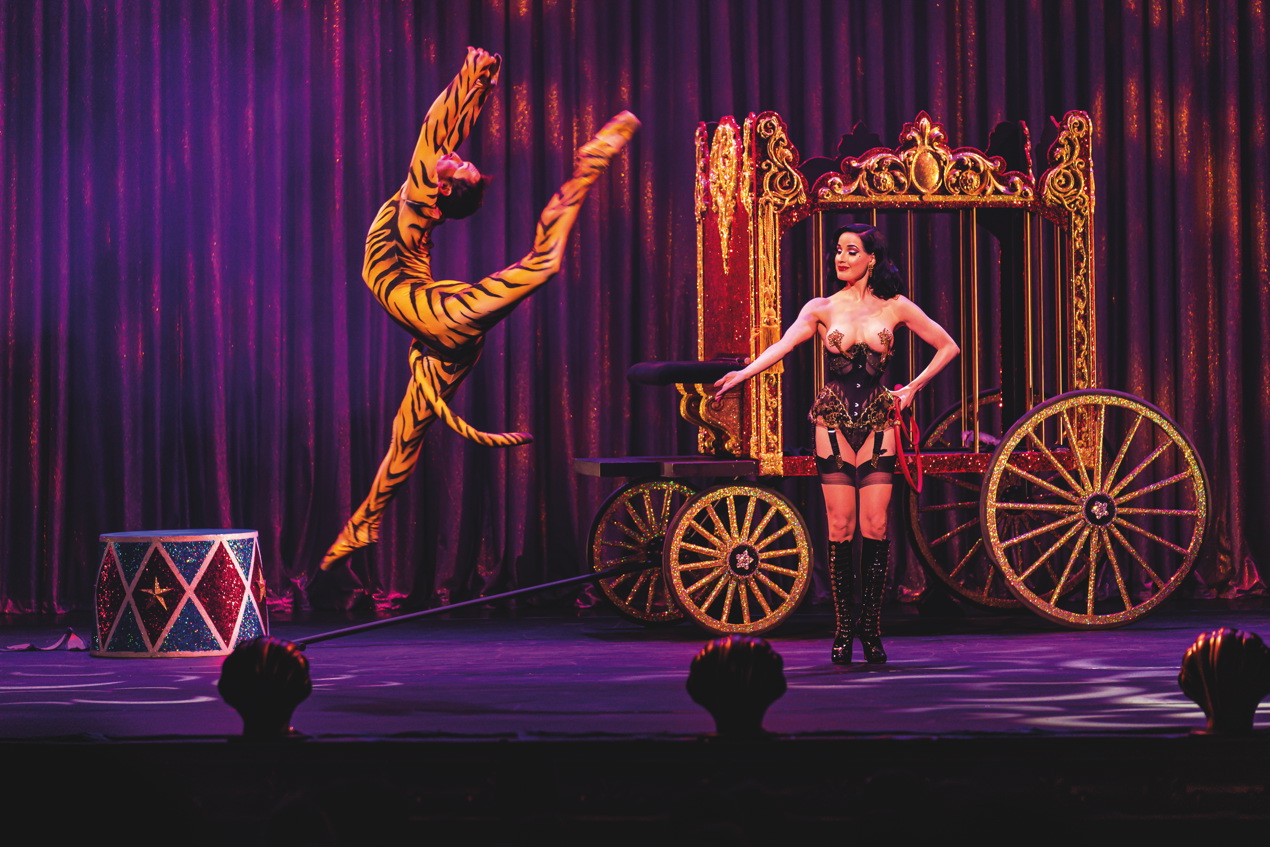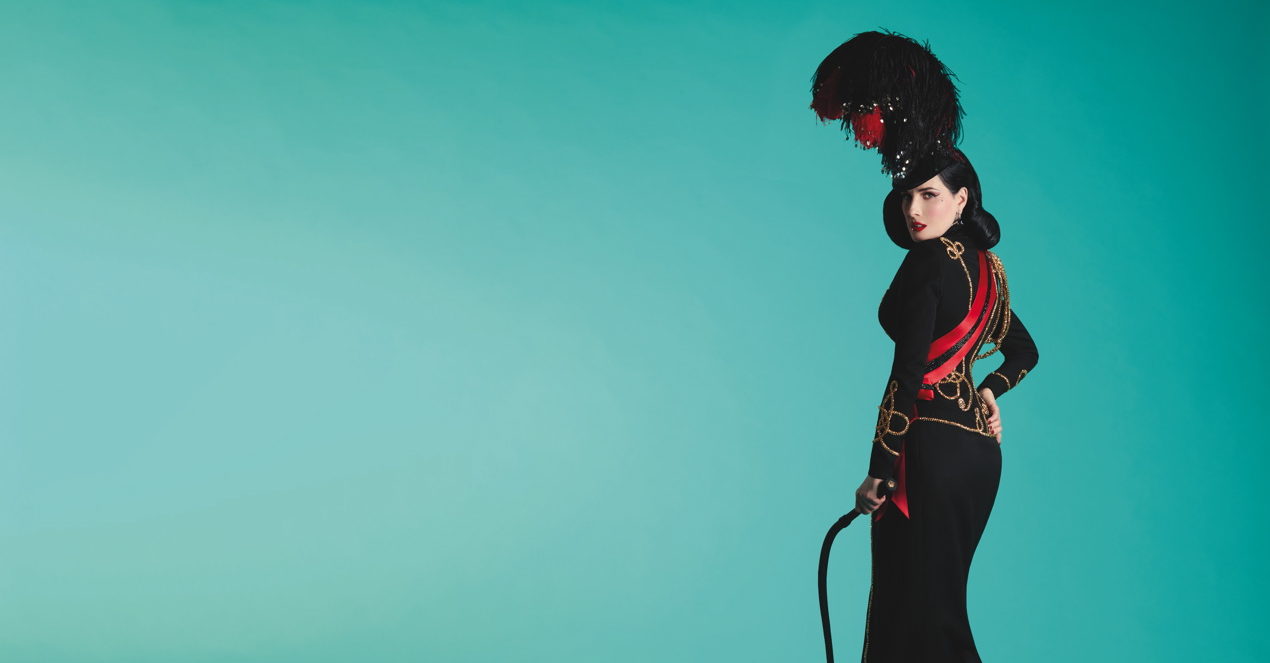Dita Von Teese: cracking the whip
Dita Von Teese is wearied by years claiming that burlesque isn’t anti-feminist. But her new show, she tells Susan Griffin, will be confirmation the diamond-encrusted campaign has been won
As a burlesque superstar, Dita Von Teese often takes to the stage smothered in thousands of Swarovski crystals or laced in haute couture, but it’s more than just dress-up for the American performer. She lives and breathes vintage glamour, which is why, despite the fact there’s no impending curtain call when we meet in the grand surroundings of the London Palladium, she’s wearing vertiginous heels, a 1940s-inspired dress that accentuates her tiny waist and her trademark raven hair perfectly styled in Victory rolls. Her porcelain face, partly covered by a black veil, is flawlessly made up with winged eyeliner and statement red lips. It’s like talking to someone who’s stepped straight out of the Golden Age of Hollywood, and the overall effect makes it difficult not to gawp.
“Women don’t have to apologise for our sexuality or for finding ways to make burlesque inspiring and empowering.”
“There are a lot of fans using vintage-style glamour for everyday life and that has been my mission statement – to tell my story about how I become more confident by looking at those eras for beauty, glamour and sensuality,” says the softly-spoken 47-year-old, whose idea of dressing down is a black cashmere jumpsuit “or a 1950s circle skirt and ballet flats”.
Her world is unapologetically glamorous and fans wallow in its splendour, and the opportunity to dress for the occasion.
“When people come to the shows, one of the biggest comments I get is: ‘I’ve never seen a place so alive with glamour.’ People feel like they’re in a time machine with everyone dressed up,” says Von Teese, who came to worldwide prominence in the noughties, not only as a femme fatale pin-up but as the fiancé of Marilyn Manson, who she married in 2005 and divorced two years later.
The life she inhabits now is a world away from her mid-western upbringing in small-town Michigan. Born Heather Renee Sweet, a natural blonde, her father was a machinist and her mother a manicurist. The family, including her two sisters, later moved to California where Von Teese attended high school in Irvine. Her mum was fascinated by old Hollywood and, vicariously, her middle daughter became captivated by the glamour that typified the era.
Wearing vintage also provided a way to express herself without the price tag.
“I couldn’t afford the designer clothes my friends had,” she recalls. “I was looking to get a stylish look for less and back in the 1980s people weren’t that into vintage yet, so it was easy to attain. It was very much a beach high school, so very casual, but it was just me trying to find my own style.”
Her look might’ve distinguished her from her peers, but it was never a source of contention. “I didn’t get made fun of until I was out of high school and dressing more eccentrically and hanging out with drag queens and club kids. I was going out in corsets, wearing more make-up and styling my hair in extravagant ways,” says Von Teese, who trained as a ballet dancer until her mid-teens when she realised she’d peaked.
Fashion has remained a constant passion though, from the elaborate lingerie she sold as a sales assistant to the historic costuming she studied.
Although she aspired to become a costume designer, her modelling took off, particularly in the fetish world where Von Teese gained prominence for corset training and her distinct look. In a world of blonde glamour models, she stood out as a modern-day Bettie Page and soon became a Playboy star. By the time she landed her first Playboy cover, she’d been performing burlesque for almost a decade, starting out in 1992.
Despite the confidence she exudes on stage, Von Teese doesn’t describe herself as an exhibitionist, which is why she delights in the structure of burlesque.
“One of the things I love about it is that it gives you a place to control the confidence levels,” says Von Teese. “I feel confident on stage, in glamorous costumes and stunningly lit tableaus.”
And it strikes a chord with the predominantly female and LGBTQ audience.

“When I first started in the 1990s, when I was touring strip clubs, I definitely had a more straight, male audience. That shifted a lot in the 2000s when I brought out my first book [Burlesque and the Art of the Teese] and told my story about why I love burlesque and pin-up. I think that story resonated with people like me.”
It’s why she regularly reminds people they can copy the tricks she uses on stage in real life.
“We have all these smart lightbulbs now, so you can create beautiful lighting tableaus in your bedroom, your bathroom, anywhere you want. Pink spotlights make everyone look beautiful.”
Described as the Queen of Burlesque, she is largely responsible for the emergence of neo-burlesque, a combination of classic components, such as striptease, and traditional revue acts, including comedy, magic and dance.
“I enjoy looking outside striptease for other ways I can bring glamour and the essence of burlesque together,” says Von Teese, who’s known for using extravagant props, including her signature martini glass and a giant, sparkling lipstick. In 2005, she made headlines when she wore nothing but $5 million worth of diamonds at a benefit in New York. A year later, she became the first guest star at the renowned Paris cabaret show Crazy Horse.
“I love to work out really complicated routines because it would be boring if it was just easy, but sometimes things don’t go to plan,” she admits, recalling the time her corset lace got caught in her heel. “I always try and anticipate what could happen, but it’s not always possible.”
Although Von Teese has almost 30 years of experience on stage, there is still a sense of trepidation before each routine. “I feel nervous in the sense I want the people to like the show and I want to give my best performance, but I’m not nervous like: ‘Oh my goodness, I can’t do this.’ I always say it’s a little bit like a rollercoaster. Before, you’re thinking: ‘Oh god, what am I doing? I can’t get out of this now.’ And then the curtains open and it’s a really fun ride. It’s natural and easy for me – once I’ve done the preparation.”
Next month she embarks on the UK leg of her Glamonatrix tour, billed as the “most lavish touring burlesque show in history”. She’ll be joined by some of the biggest names in the industry, including America’s Dirty Martini and Australia’s Zelia Rose.
“This show has a lot of similarities to the last one, The Art of the Teese, in that it follows the same format as my classic American burlesque variety show. However, this time I’m interacting a lot more with the cast. It’s more fun than ever to start taking the show in that direction rather than me on stage on my own,” says Von Teese, who oversees every aspect, from the sets and costumes to the music and lighting.
“I’ve always cast the show quite organically with diversity in body shape, age and gender. The diversity of beauty comes naturally because the great burlesque performers are all different kinds of people who are evolving the art of burlesque. So I’m not just asking people to come see my show – it’s a careful curation of the world’s best burlesque performers, which really challenges the norms of what’s considered striptease and burlesque. I’m really proud, not only of what I’m doing, but of the other performers I’m shining the spotlight on too.”
Von Teese has always believed burlesque celebrates diversity and is thankful that’s now widely recognised. The accusation that what she does is anti-feminist is also waning.
“I feel like finally people are understanding we [women] don’t have to apologise for our sexuality or indulging in a burlesque show or for finding ways to make a burlesque show inspiring and empowering. It’s about understanding the core values of feminism and knowing they are not what they were in the past. Now it’s about respecting each woman’s boundaries and each woman’s perspective on it instead of judging each another.”
But she admits it’s been frustrating to constantly defend burlesque over the years.
“I just felt like, how many times do I have to explain this? You’d think people would just come to the show and write about what the scene looks like, and why people are coming to a burlesque show instead of just judging it from afar. That’s what really matters to me now – for people to come and really look at who’s in the audience, maybe ask them why they’re there, what they love about a burlesque show.’
As she approaches 50, she is contemplating the next stage of her career, and how long she’d like to perform, but it will be on her terms, as it always has.
“There’s an evolution that comes as a woman and having a message and something to say to people. I’m not doing the same shows I did in the 1990s. I love producing and every time I create a new show, I think, where I am now in my life? Do I feel strong, do I feel good, do I love doing this still? Or do I want to direct other performers? It’s about my personal preference, and I’m always evolving.”
Glamonatrix is at the O2 Apollo, Manchester, 14 April (myticket.co.uk)
